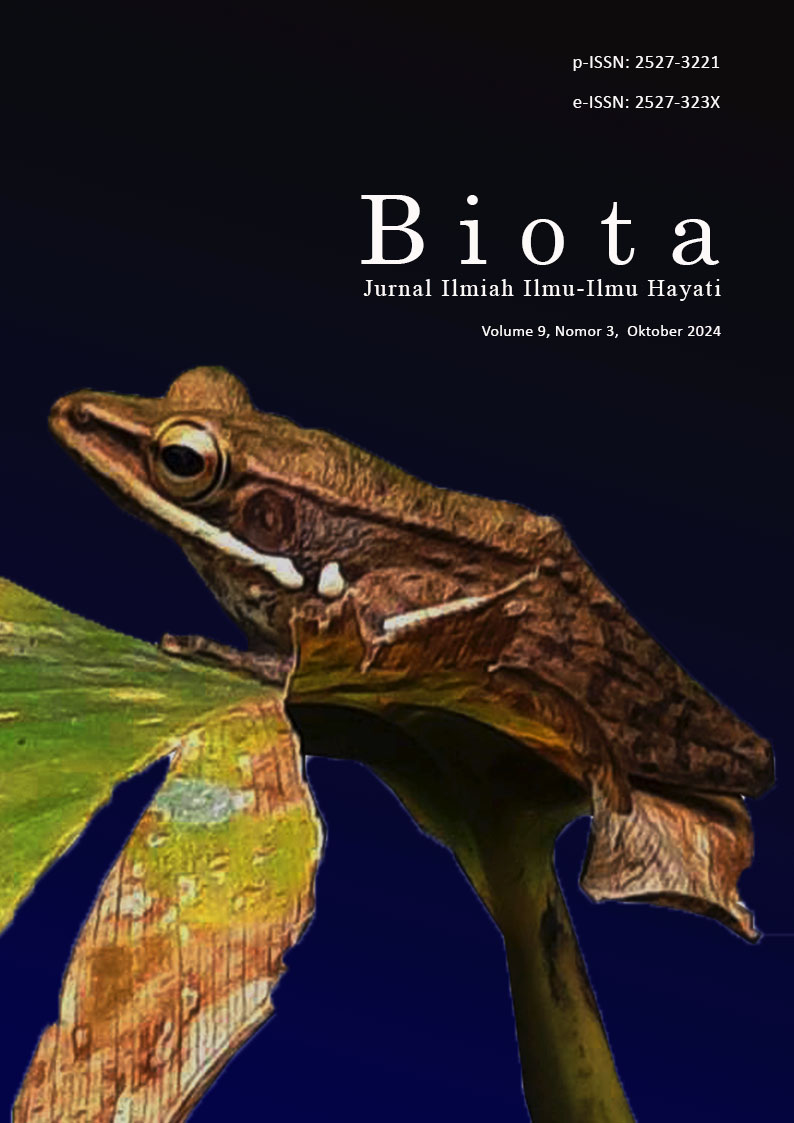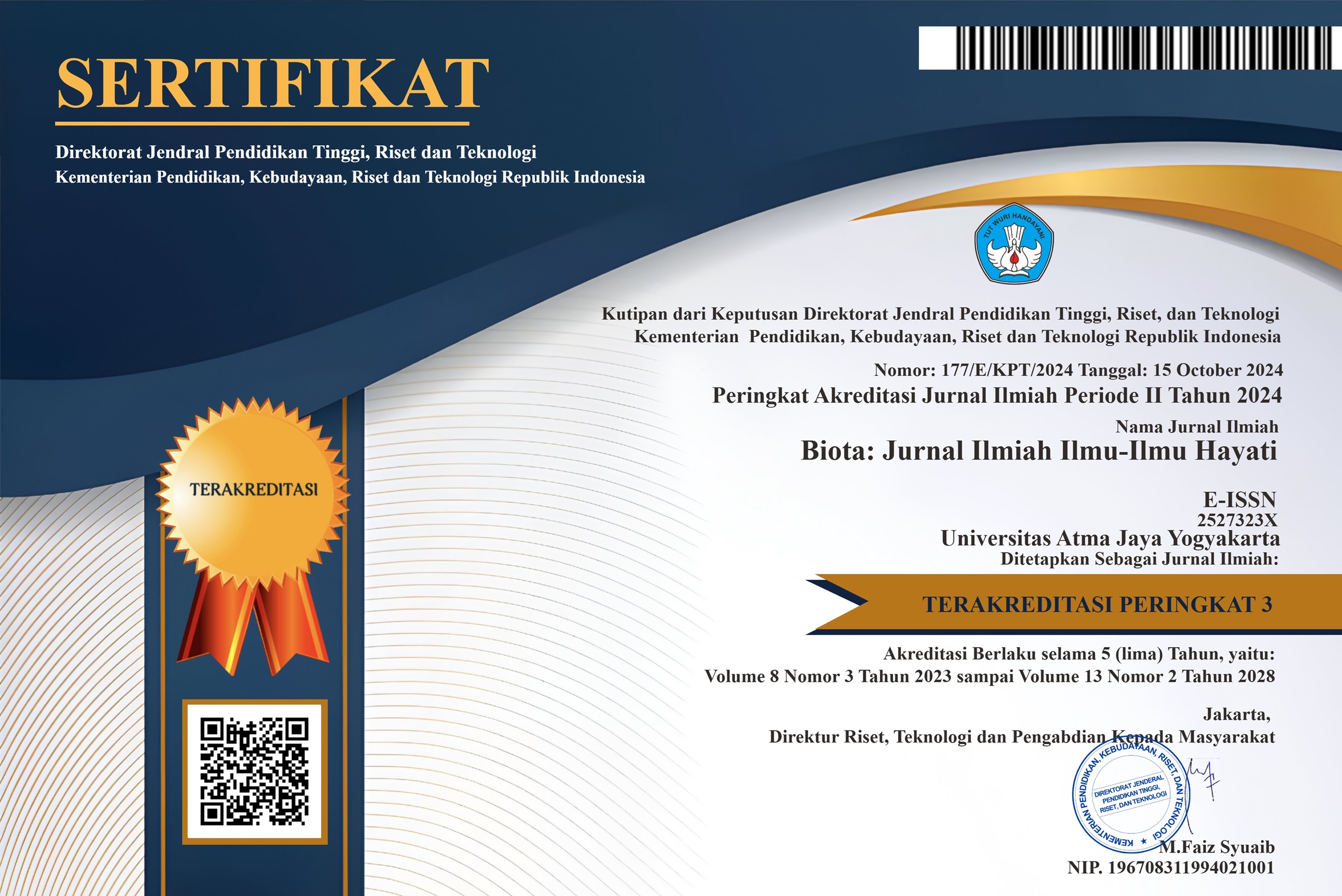Multiplikasi Tunas pada Eksplan Rimpang Kunyit Hitam (Kaempferia parviflora) dengan Penambahan Hormon BAP
DOI:
https://doi.org/10.24002/biota.v9i3.8534Keywords:
BAP, Kunyit hitam (Kaempferia parviflora), multiplikasi tunas, MS (Murashige and Skoog), rimpangAbstract
Kunyit Hitam (Kaempferia parviflora) adalah tanaman rimpang berwarna ungu kehitaman yang banyak manfaat sebagai bahan obat tradisional. Perbanyakan bibit kunyit hitam secara konvensional tidak memungkinkan untuk budidaya skala besar, dikarenakan membutuhkan waktu yang cukup lama dan tidak efisien. Rendahnya pasokan bahan tanaman berkualitas dan masalah perkecambahan yang rendah menjadi dasar dalam upaya pengembangan kunyit hitam secara in vitro. Perbanyakan kunyit hitam melalui multiplikasi tunas dapat mempercepat produksi bibit yang efisien. Penelitian ini bertujuan untuk mengetahui pengaruh pemberian berbagai konsentrasi hormon BAP terhadap multiplikasi kunyit hitam. Rancangan penelitian menggunakan RAL dengan faktor konsentrasi hormon BAP yang terdiri dari 5 taraf konsentrasi antara lain BAP 0 mg/L (P0), BAP 2 mg/L (P1), BAP 4 mg/L (P2), BAP 6 mg/L (P3), dan BAP 8 mg/L (P4). Hasil penelitian menunjukkan bahwa, perlakuan BAP 2 mg/L memperlihatkan hasil terbaik dengan kedinian tunas tercepat yaitu 8,3 hari setelah tanam, jumlah tunas terbanyak yaitu 5,8 tunas, rata-rata tunas tertinggi mencapai 4,8 cm, dan jumlah daun terbanyak yaitu 8,3 helai. Perlakuan BAP 2 mg/L menghasilkan persentase tunas dan akar 100%.
References
Alagarsamy, K., Shamala, L. F., & Wei, S. (2018). Influence of media supplements on inhibition of oxidative browning and bacterial endophytes of Camellia sinensis var. sinensis. 3 Biotech 8(8):1–7.
Al-Jalihawi, W. F. H., Ali, T. J. M., & Nayef, M. N. (2023). Comparative Study between the Growth Regulators Benzyl Adenine (BAP) and Thydizoronate (TDZ) and Nano Iron in the Growth and Multiplication of Citrumelo Shoots in Vitro. IOP Conference Series: Earth and Environmental Science 1158(4): 1755 - 1315.
Aprilia, M., Setiari, N., & Nurchayati, Y. (2022). Callus Development from Potato (Solanum tuberosum) Stem at Various Concentrations of Benzylaminopurine. Biosaintifika 14(2): 219–225.
Azizan, M. N. A. B., & Risda. (2017). The Effect of BAP and NAA Treatment on Micropropagation of Cucumis sativus.L. International Journal Of Science And Research, 6(11), 170–176. https://doi.org/10.21275/ART20177887
Elshamy, A. I., Mohamed, T. A., Essa, A. F., Abd-Elgawad, A. M., Alqahtani, A. S., Shahat, A. A., Yoneyama, T., Farrag, A. R. H., Noji, M., El-Seedi, H. R., Umeyama, A., Paré, P. W., & Hegazy, M. E. F. (2019). Recent advances in Kaempferia phytochemistry and biological activity: A comprehensive review. In Nutrients 11(10)
George, E., Hall, M., & De Klerk, J. (2008). Plant Growth Regulators II: Cytokinins, their Analogues and Antagonists. Plant Propagation by Tissue Culture 3rd Edition Volume 1 The Backgorund. In Springer. Dordrecht. 205-226.
Kafindra, L., Khumaida, N., & Wahyuning Ardie, S. (2015). Induksi Rimpang Mikro Kaempferia parviflora secara In Vitro dengan Penambahan BAP dan Sukrosa. Jurnal Hortikultura Indonesia 6(1): 54–63.
Karim, M. A., Ardie, S. W., & Khumaida, N. (2014). Pematahan Dormansi Rimpang Kaempferia parviflora Wall. ExBaker. Buletin Agrohorti 2(1) : 104 – 114.
Khairudin, N. A., Haida, Z., & Hakiman, M. (2020). In Vitro Shoot and Root Induction of Kaempferia parviflora (Zingiberaceae) Rhizome Using 6-Benzylaminopurine. Journal of Tropical Plant Physiology 12(2): 10.
Kurepa, J., & Smalle, J. A. (2022). Auxin/Cytokinin Antagonistic Control of the Shoot/Root Growth Ratio and Its Relevance for Adaptation to Drought and Nutrient Deficiency Stresses. International Journal of Molecular Sciences, 23(4): 1-15. https://doi.org/10.3390/ijms23041933
Labrooy, C., Abdullah, T. L., & Stanslas, J. (2020). Influence of N6-Benzyladenine and Sucrose on In Vitro Direct Regeneration and Microrhizome Induction of Kaempferia parviflora Wall . Ex Baker, An Important Ethnomedicinal Herb of Asia. Tropical Life Sciences Research 31(1): 123.
Letsyo, E., Jerz, G., Winterhalter, P., & Beuerle, T. (2017). Toxic pyrrolizidine alkaloids in herbal medicines commonly used in Ghana. Journal of Ethnopharmacology 202(1): 154–161.
Lian, X., Liu, S., Sikandar, A., Kang, Z., Feng, Y., Jiang, L., & Wang, Y. (2023). The influence of 6-Benzylaminopurine (BAP) on yield responses and photosynthetic physiological indices of soybean. Kuwait Journal of Science 50(3): 345–352.
Liu, S., Strauss, S., Adibi, M., Mosca, G., Yoshida, S., Dello Ioio, R., Runions, A., Andersen, T. G., Grossmann, G., Huijser, P., Smith, R. S., & Tsiantis, M. (2022). Cytokinin promotes growth cessation in the Arabidopsis root. Current Biology 32(9): 1974-1985.
Ogunyale, O. G., Fawibe, O. O., Ajiboye, A. A., & Agboola, D. A. (2014). A Review of Plant Growth Substances: Their Forms, Structures, Synthesis and Functions. Journal of Advanced Laboratory Research in Biology 5(4): 152–168.
Pakkirisamy, M., Kalakandan, S. K., & Ravichandran, K. (2017). Phytochemical screening, GC-MS, FT-IR analysis of methanolic extract of Curcuma caesia roxb (black turmeric). Pharmacognosy Journal 9(6): 952–956.
Park, H. Y., Kim, K. S., Ak, G., Zengin, G., Cziáky, Z., Jekő, J., Adaikalam, K., Song, K., Kim, D. H., & Sivanesan, I. (2021). Establishment of A Rapid Micropropagation System For Kaempferia parviflora wall. Ex baker: Phytochemical analysis of leaf extracts and evaluation of biological activities. Plants 10(4): 1-24.
Peng, M. X., Chen, R. M., Wei, Q., Guo, H. R., Zeng, R. Z., Xie, L., Zhang, Z. S., & Chen, J. (2023). Effects of Genotype, Light, and Plant Growth Regulators on Rhizome Browning, Proliferation, and Sprouting in Cymbidium. HortScience 58(6): 671–676.
Raihana, R., Faridah, Q. Z., Julia, A. A., Abdelmageed, A. H. A., & Kadir, M. A. (2011). In Vitro Culture Of Curcuma mangga From Rhizome Bud. Journal of Medicinal Plant Research 5(28): 6418–6422.
Rostami, S., & Azhdarpoor, A. (2019). The Application of Plant Growth Regulators To Improve Phytoremediation of Contaminated Soils: A review. Chemosphere 220: 818–827.
Rustikawati, R., Herison, C., Inoriah, E., & Dwisari, V. (2021). Effect of BAP (6-Benzyl Aminopurine) on In Vitro Shoot Growth of Curcumas. AGRITROPICA : Journal of Agricultural Sciences 4(1): 82–92.
Samanhudi, Pujiasmanto, B., & Dewi, E. P. (2021). Kajian Konsentrasi BAP dan NAA terhadap Multiplikasi Jahe Merah (Zingiber officinale Var. Rubrum) In Vitro. Agrica Ekstensia 15(1): 13–20.
Shukla, S. K., Shukla, S., Koche, V., & Mishra, S. K. (2007). In Vitro Propagation of Tikhur (Curcuma angustifolia Roxb.): A Starch Yielding Plant S. Indian Journal of Biotechnology 6(4): 274–276.
Singh, A., Singh, N., Singh, S., Srivastava, R. P., Singh, L., Verma, P. C., Devkota, H. P., Rahman, L. ur, Kumar Rajak, B., Singh, A., & Saxena, G. (2023). The Industrially Important Genus Kaempferia: An Ethnopharmacological Review. Frontiers in Pharmacology 14(2): 1–18.
Sjahril, R., Haring, F., Riadi, M., Danial Rahim, M., Sher Khan, R., Amir, A., & R, T. A. (2016). Performance of NAA, 2iP, BAP and TDZ on Callus Multiplication, Shoots Initiation and Growth for Efficient Plant Regeneration System in Chrysanthemum (Chrysanthemum morifolium Ramat.). International Journal of Agriculture System (IJAS). 4(1): 52-61.
Street, I. H., Mathews, D. E., Yamburkenko, M. V., Sorooshzadeh, A., John, R. T., Swarup, R., Bennett, M. J., Kieber, J. J., & Schaller, G. E. (2016). Cytokinin acts through the auxin influx carrier AUX1 to regulate cell elongation in the root. Development (Cambridge), 143(21): 3982–3993. https://doi.org/10.1242/dev.132035
Widhiastuty, N. S., Anwar, S., & Rosyida. (2023). The Effect of PVP (Polivinil Pirolidon) and BAP (6- benzylamino purine) on Shoots Induction of Teak Plus Perhutani (Tectona grandis). IOP Conference Series: Earth and Environmental Science 1246(1): 1–12.
Wu, W., Du, K., Kang, X., & Wei, H. (2021). The diverse roles of cytokinins in regulating leaf development. In Horticulture Research, 8(118): 1-13.
Yamoune, A., Zdarska, M., Depaepe, T., Rudolfova, A., Skalak, J., Berendzen, K. W., Mira-Rodado, V., Fitz, M., Pekarova, B., Nicolas Mala, K. L., Tarr, P., Spackova, E., Tomovicova, L., Parizkova, B., Franczyk, A., Kovacova, I., Dolgikh, V., Zemlyanskaya, E., Pernisova, M., Hejatko, J. (2024). Cytokinins regulate spatially specific ethylene production to control root growth in Arabidopsis. Plant Communications, 0(0): 1-17.
Yulizar, D. R., Noli, Z. A., & Idris, M. (2014). Induksi Tunas Kunyit Putih (Curcuma zedoaria Roscoe) pada Media MS dengan Penambahan Berbagai Konsentrasi BAP dan Sukrosa Secara In Vitro. Journal of Chemical Information and Modeling 3(4): 310–316.
Yunus, A., Rahayu, M., Samanhudi, Pujiasmanto, B., & Riswanda, H. J. (2016). Respon Kunir Putih (Kaempferia rotunda) terhadap Pemberian IBA dan BAP pada Kultur In Vitro. Agrosains 18(2): 44–49.
Zhiyong, Z., Baomin, F., Chao, S., Xiaoxian, Z., Qingwen, Z., & Bing, Y. (2022). Advances in Root System Architecture: Functionality, Plasticity, and Research Methods. Journal of Resources and Ecology, 14(1): 15–24. https://doi.org/10.5814/j.issn.1674-764x.2023.01.002
Zulfa, U. (2012). Application of Liquid Bio-Fertilizer Reduced The Need of Chemical Fertilizer In Black Galingale (Kaempferia Parviflora) Production [Disertasi Skrips]. Bogor. Institut Pertanian Bogor.
Downloads
Published
How to Cite
Issue
Section
License
Copyright (c) 2024 Didik Pudji Restanto, Fairuz Luthfi Hanifah, Mohammad Candra Prayoga, Fauziatuz Zahro, Mohammad Nur Khozin

This work is licensed under a Creative Commons Attribution-NonCommercial 4.0 International License.
Authors who publish with Biota : Jurnal Ilmiah Ilmu-Ilmu Hayati agree to the following terms:
- Authors retain copyright and grant the Biota : Jurnal Ilmiah Ilmu-Ilmu Hayati right of first publication. Licensed under a Creative Commons Attribution-NonCommercial 4.0 International License that allows others to share the work with an acknowledgment of the work's authorship and initial publication in this journal.
- Authors are able to enter into separate, additional contractual arrangements for the non-exclusive distribution of the journal's published version of the work (e.g., post it to an institutional repository or publish it in a book), with an acknowledgment of its initial publication in Biota : Jurnal Ilmiah Ilmu-Ilmu Hayati, and as long as Author is not used for commercial purposes.













